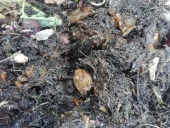posted 11 years ago
I'm a big user of mulch, but I live in Hawaii. So my situation is quite different from yours. But regardless of location, one needs to understand how mulch works.
1- Type of material used for mulching can make a big difference. Each type reacts differently with the environment, so you get different results. In my experience, newspaper/cardboard tends to keep rainwater from penetrating if the layers are too thick. More than a dozen sheets of newspaper and the mulch becomes a water blocker. BUT once the ground is wet, thick paper can tend to keep the moisture there. That's why an old pile of newspaper left abandoned in the garden has wet soil under it even during a drought. Get the newspaper layer thicker than a half inch and the dry ground under it doesn't get wet even in a heavy rain. Thick newspaper is glued together (Chemically? Biofilm? Mechanically?) making it virtually impossible for water to filter through it. Instead the water finds a channel to drain away.
Fine, fresh grass clippings can be a good mulch but only if thinly applied. Applied thickly it initially heats up, often killing or damaging the plants you are mulching.Then as it cools down, it forms a gley-like layer which can prevent water from percolating through it while also robbing the soil microbes of oxygen. So for best results I apply grass clippings in light layers, adding a bit more each week or two.
Chopped weeds make a good mulch even if applied several inches deep. I find that they are stemmy and coarse enough not to compact. Thus they allow air circulation while allowing water penetration.
Tree leaves are highly variable because some are fine, some coarse. Some tend to compact while others do not. Some rather quickly affect the soil ecology, changing the pH, causing rapid depletion of nitrogen, or adding compounds that effect other plants. I include pine needles in this group. For some crops, pine needles may be beneficial while for others they are not. And the applied thickness has a bearing on leaf mulch too.
Wood chips are a popular mulch. They too have their pros and cons. Applied to the soil surface and not disturbed, I find them to be fine for my flower beds. But if I flip them in while replanting the beds, then I run into trouble. At least the wood chips that I have access to will deplete the nitrogen rather rapidly if I don't take steps to avoid it.
Compost is a popular mulch with me. My crops have short turn over times, so once a crop gets harvested I lightly turn over the mulch, thus providing fertilizer to the bed. I've had good success using coarse compost as a mulch.
2- Depth of mulch is a major factor. I've already mentioned this. Some mulches are just as good at excluding moisture as they are at retaining it. Some plants thrive with deep mulches while others do not. It's not only a moisture thing but also an oxygen/gasses thing.
3- Time of year applied. While my ground temperature doesn't vary as wildly as it does on the mainland, I still must be aware of it for certain crops. Mulch will prevent the sun from heating up the soil.....which s good during hot summers. But if the soil is too cool for a certain crop, then applying mulch is a mistake. Mulch will prevent the soil temperature from increasing, thus the crop will fail or do poorly. Therefore I will not apply thick mulch when I plant beans until the plants are 6 " high. For soybeans and okra, I will only use light mulching in order to keep the soil warmer unless we suddenly go into drought. Less moisture in the soil causes the temperature to increase, thus it will be warm enough so now I need to focus on moisture retention.....something that mulch can do pretty well.
I always use mulch to protect the soil microbes, even when I'm trying to warm the soil up. I never allow the soil surface to go completely bare or dry for long. A sparse mulch will help protect the soil while still allowing for warming. I don't want to sterilize my soil. I made that mistake once of allowing the soil to sit exposed to the sun for several weeks and as a result it took months to get that soil productive again (I choose not resort to chemical fertilizers).
Specifically about potatoes, a crop under mulch could fail for a variety of reasons. Soil temperature, initial moisture content, type of mulch, depth of mulch all have a bearing. A local gardener tried growing potatoes under a thick mulch like I do and she failed. Came to find out that she did not get the seed potatoes to start sprouting first PLUS she was using store bought tubers. Store bought ones are often chemically treated to retard sprouting. And if potato seed is not pre sprouted, it may rot while it is awaiting to break out of dormancy. I've had excellent results producing potatoes under a 6 inch deep compost mulch where I reapply more mulch 39 days into the growing period. The potatoes end up under a 10-12 inch mulch. They are very productive and easy to harvest this way. I can harvest every 60-120 days depending upon the variety. By the way, I don't normally have problems with me in the garden, but if one grows potatoes under just mulch, mice can eat your spuds before they have a chance to grow.
Hope this gives you some ideas.
It's never too late to start! I retired to homestead on the slopes of Mauna Loa, an active volcano. I relate snippets of my endeavor on my blog : www.kaufarmer.blogspot.com






 2
2




 3
3




















 2
2



















